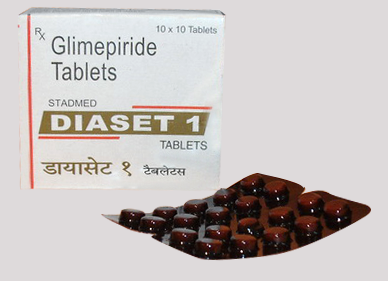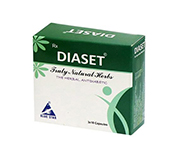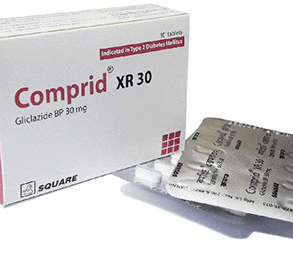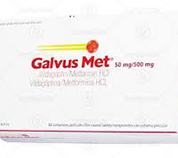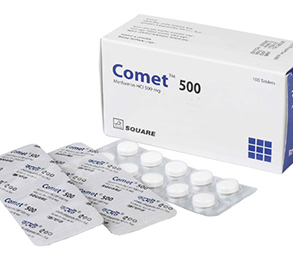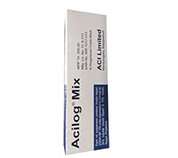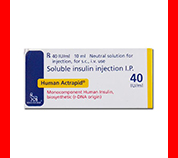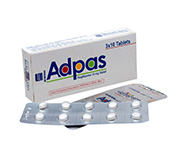Diaset Tablet 25 mg 1 Pcs
Alternative products
Miglitol
Indications
Miglitol is indicated as an adjunct to diet and exercise to improve glycemic control in adults with type 2 diabetes mellitus.
Pharmacology
Miglitol reversibly inhibits membrane-bound intestinal α-glucosidase enzymes which hydrolyse oligosaccharides and disaccharides to glucose and other monosaccharides in the small intestinal brush border. It delays carbohydrate breakdown, glucose absorption and reduces postprandial hyperglycaemia.
Dosage
There is no fixed dosage regimen for the management of diabetes mellitus with Miglitol Tablets or any other pharmacologic agent. Dosage of Miglitol must be individualized on the basis of both effectiveness and tolerance while not exceeding the maximum recommended dosage of 100 mg 3 times daily. Miglitol should be taken three times daily at the start of each main meal. Miglitol should be started at 25 mg, and the dosage gradually increased both to reduce gastrointestinaladverse effects and to permit identification of the minimum dose required for adequate glycemic control of the patient. During treatment initiation and dose titration one-hour postprandial plasma glucose may be used to determine the therapeutic response to Miglitol and identify the minimum effective dose for the patient.
Thereafter, glycosylated hemoglobin should be measured at intervals of approximately 3 months. The therapeutic goal should be to decrease both postprandial plasma glucose and glycosylated hemoglobin levels to normal or near normal by using the lowest effective dose of Miglitol, either as monotherapy or in combination with a sulfonylurea.
Initial Dosage: The recommended starting dosage of Miglitol is 25 mg, given orally three times daily at the start of each main meal. However, some patients may benefit by starting at 25 mg once daily to minimize gastrointestinal adverse effects, and gradually increasing the frequency of administration to 3 times daily.
Maintenance Dosage: The usual maintenance dose of Miglitol is 50 mg taken 3 times daily, although some patients may benefit from increasing the dose to 100 mg 3 times daily. To allow adaptation to potential gastrointestinal adverse effects, it is recommended that Miglitol therapy be initiated at a dosage of 25 mg 3 times daily, then gradually titrated upward to allow adaptation. After 4 to 8 weeks of the 25 mg 3 times daily regimen, the dosage should be increased to 50 mg 3 times daily for approximately three months, following which a glycosylated hemoglobin level should be measured to assess therapeutic response. If at that time, the glycosylated hemoglobin level is not satisfactory, the dosage may be further increased to 100 mg 3 times daily, the maximum recommended dosage.
Maximum Dosage: The maximum recommended dosage of Miglitol is 100 mg 3 times daily. In one clinical trial, 200 mg 3 times daily gave additional improved glycemic control but increased the incidence of the gastrointestinal symptoms described above.
Patients Receiving Sulfonylureas: Sulfonylurea agents may cause hypoglycemia. There was no increased incidence of hypoglycemia in patients who took Miglitol in combination with sulfonylurea agents compared to the incidence of hypoglycemia in patients receiving sulfonylureas alone in any clinical trial. However, Miglitol given in combination with a sulfonylurea will cause a further lowering of blood glucose and may increase the risk of hypoglycemia due to the additive effects of the two agents. If hypoglycemia occurs, appropriate adjustments in the dosage of these agents should be made
* চিকিৎসকের পরামর্শ মোতাবেক ঔষধ সেবন করুন'
Administration
Should be taken with food. Take with 1st bite of each main meal.
* চিকিৎসকের পরামর্শ মোতাবেক ঔষধ সেবন করুন'
Interaction
Concomitant use with insulin increases the risk of hypoglycaemia. Intestinal adsorbents (e.g. charcoal) and carbohydrate-splitting digestive enzyme supplements (e.g. amylase, pancreatin) may reduce glycaemic effects. May significantly reduce the bioavailability of ranitidine and propranolol.
Contraindications
Patient with diabetic ketoacidosis, inflammatory bowel disease, colonic ulceration, partial intestinal obstruction or predisposition to this condition, chronic intestinal diseases associated with marked disorders of digestion or absorption and co-existing conditions that may deteriorate as a result of increased intestinal gas formation.
Side Effects
Abdominal pain or discomfort, diarrhoea, flatulence, skin rash.
Pregnancy & Lactation
Category B: Either animal-reproduction studies have not demonstrated a fetal risk but there are no controlled studies in pregnant women or animal-reproduction studies have shown an adverse effect (other than a decrease in fertility) that was not confirmed in controlled studies in women in the 1st trimester (and there is no evidence of a risk in later trimesters).
Precautions & Warnings
Patient exposed to stress (e.g. fever, trauma, infection, surgery). Renal impairment. Pregnancy and lactation.
Therapeutic Class
Alpha-Glucosidase inhibitor
Storage Conditions
Store at 25° C.
- Type Tablet
- Tag
- Morbi leo risus
- Porta ac consectetur ac
- Vestibulum at eros
